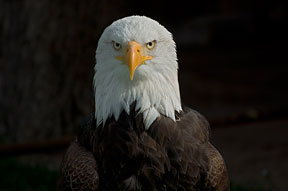Alerts
Please be advised that our bird aviaries are open!
Your Toronto Zoo is committed to the health and safety of the animals in our care. We take proactive steps to protect our birds from Avian Influenza which has been confirmed in a wild bird in southern Ontario, and some birds may still be off display.
Please note Splash Island is still closed and will not open until July due to unforeseen delays in construction. Please watch for updates on https://www.torontozoo.com/tz/splash or on our social media pages. Thank you!
Please note the following animals are currently not on display due to various reasons including Avian Bird Flu, and Covid-19 sensitivity:
- Flamingo, peacock, owl, bald eagle, and aviaries
- Some Kids Zoo Animals
- Cougar
- Moose
- Kangaroo walk through (kangaroos are still visible)
- Axolotl
We apologize for the inconvenience!


Bird
Location at the Zoo:
Canadian Domain
Region: North America
Northern bald eagle
The adult has a distinctive snow white head and tail. The body is brownish black. The large bill, eyes and feet are bright yellow. In immature birds the tail, head and body are dark brown, less black than adults, and show some white on the underside of the wings. In some, the plumage is irregularly but extensively blotched with cream or white, with the bill brownish, eyes pale yellow-gray, feet lemon yellow. They take four to five years to acquire adult colouration. Females are larger than males weighing approximately 5.8 kg on average, where as males weight 4.1 kg. Wingspan can reach up to 2.44 m.Conservation Status: IUCN

Distribution:
This northern subspecies, H. l. alascanus, occur in northern and eastern Canada, the northern United States including Alaska. They range further south on the Atlantic coast. Although their distribution is widespread, numbers vary regionally. Ontario northern populations are healthier than those in the south.Habitat:
They prefer areas with an abundance of lakes, large rivers, sea coasts and surrounding areas of old-growth and mature stands of coniferous or hardwood trees. Trees selected for perching, roosting, and nesting must have good visibility, an open structure, and proximity to prey.Diet:
These eagles feed largely on fish either self caught or taken from Osprey. Birds and small mammals such as muskrats, squirrels, and rabbits are also consumed. They scavenge for carrion and catch injured and crippled water fowl during or after the hunting season.Reproduction:
It is surmised that these raptors mate for life. Breeding season lasts from December to April, although it begins earlier in the most southerly range. It is timed so that hatching coincides with abundant food supplies. These eagles use the same nest each year. They build a huge aerie (nest) of sticks and twigs, or in northern climes on rocky cliffs. The nest takes weeks to construct and is increased yearly. The female usually lays two eggs (pale blue to white). Incubation is shared by both parents and takes 35 days. Fledgling takes 10 to 11 weeks with usually one chick surviving to maturity. As the chicks grow they learn to tear up their own food and the parents leave them for longer periods. The chicks practice flying from the aerie but return nightly. This continues until the parents force them to move at the end of summer. Breeding occurs after maturity at four to six years of age.Adaptation:
Bald eagles are very powerful fliers with broad wings with deeply slotted tips which are ideal for soaring and long distance flying. They soar on thermal convection currents. They can reach speeds of 56 to 70 km per hour when gliding and flapping. When diving speed is between 120 and 160 km per hour and while carrying fish, or other prey items they can fly at 48 km per hour.Their talons are long and sharp for seizing prey. They are adept fishermen and often sit at some vantage point over water waiting for fish to rise, and then swoop to scoop one from the surface. With exceptionally acute vision they will attack diving birds and strike at fish where they are, rather than where they appear to be due to refraction created by water.
They become somewhat migratory when water freezes over, and will move to areas of open water. When migration becomes necessary, routes are selected which provide the advantages of updrafts and thermals. Diurnal migrations utilize thermals produced by the sun.